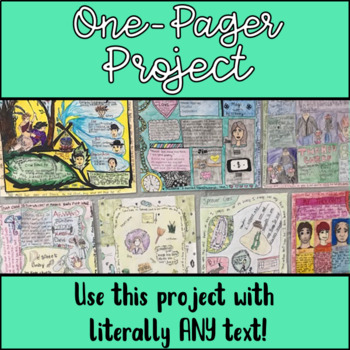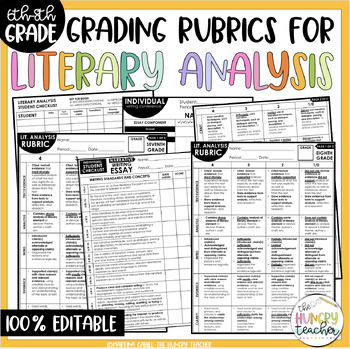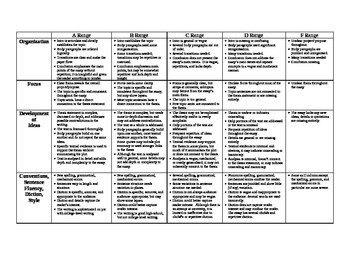Instructor Resources (material available upon log-in)
Grading rubric.
Literary analysis papers must fulfill terms of the individual instructor’s assignment and exhibit no evidence of plagiarism.
| Mastery of literary terminology
| Acceptable to good use of literary terminology | Inadequate use of literary terminology
| Little or no use of literary terminology
|
| Strong thesis statement
| Adequate to good thesis statement | Recognizable thesis with serious flaws
| No thesis |
| Strong organization, development, and textual references and explanations | Adequate to good organization, development, and textual references and explanations
| Evidence of effort, but poor organization, development, and /or textual references and explanations
| Little or no development, organization, and/or textual references and explanations |
| Strong understanding of genre’s conventions | Basic to good understanding of genre’s conventions | Little evidence of understanding of genre’s conventions | Serious errors in and/or no understanding of genre’s conventions |
| Strong analytical skills demonstrated by clarity, insights, and depth of thought in literary interpretation | Adequate to good analytical skills and evidence of critical thinking in literary interpretation | Evidence of effort, but irrelevant and/or confused thinking, faulty logic
| Substantial errors in expression of thought, meaning obscured, little or no explanation
|
| Diverse and well-integrated scholarly research when required | Adequate to good scholarly research when required | Inadequate or incorrectly applied research when required | Little or no research when required |
| Skillful and correct use of MLA documentation and paper format | Few to some errors in MLA documentation and paper format | Consistent errors in MLA documentation and paper format | Consistent and substantial errors in MLA documentation and paper format |
| Highly correct grammar, sentence structure, and style
| Few to some grammatical errors, meaning clear; serviceable to good sentence structure and style | Serious grammatical errors, obscuring meaning; weak sentence structure and weak sense of style | Many egregious grammatical errors, obscuring meaning; poor sentence structure and little or no sense of style |
- Grading Rubric. Authored by : Joshua Dickinson. Provided by : Jefferson Community College. Located at : http://www.sunyjefferson.edu . Project : American Lit 1. License : CC BY-SA: Attribution-ShareAlike

Rubric – English Grade 10 Literary Analysis Essay
| Criteria / Topics | Scoring Scale | ||||
|---|---|---|---|---|---|
| 50 | |||||
| Identification of Theme | Clearly identifies the theme of the novel and provides a thorough explanation with specific examples from the text. | Identifies the theme of the novel and provides an explanation with some examples from the text. | |||
| Use of Characters | Effectively analyzes how the author uses characters to illustrate the theme, providing detailed examples and insightful explanations. | Analyzes how the author uses characters to illustrate the theme, providing examples and explanations. | |||
| Use of Plot Events | Effectively analyzes how the author uses plot events to illustrate the theme, providing detailed examples and insightful explanations. | Analyzes how the author uses plot events to illustrate the theme, providing examples and explanations. | |||
| Use of Literary Devices | Effectively analyzes how the author uses literary devices to illustrate the theme, providing detailed examples and insightful explanations. | Analyzes how the author uses literary devices to illustrate the theme, providing examples and explanations. | |||
| Evidence from the Text | Provides ample and specific evidence from the text to support the analysis of the theme, using direct quotes and thorough explanations. | Provides evidence from the text to support the analysis of the theme, using some direct quotes and explanations. | |||
Privacy Overview
| Cookie | Duration | Description |
|---|---|---|
| cookielawinfo-checkbox-analytics | 11 months | This cookie is set by GDPR Cookie Consent plugin. The cookie is used to store the user consent for the cookies in the category "Analytics". |
| cookielawinfo-checkbox-functional | 11 months | The cookie is set by GDPR cookie consent to record the user consent for the cookies in the category "Functional". |
| cookielawinfo-checkbox-necessary | 11 months | This cookie is set by GDPR Cookie Consent plugin. The cookies is used to store the user consent for the cookies in the category "Necessary". |
| cookielawinfo-checkbox-others | 11 months | This cookie is set by GDPR Cookie Consent plugin. The cookie is used to store the user consent for the cookies in the category "Other. |
| cookielawinfo-checkbox-performance | 11 months | This cookie is set by GDPR Cookie Consent plugin. The cookie is used to store the user consent for the cookies in the category "Performance". |
| viewed_cookie_policy | 11 months | The cookie is set by the GDPR Cookie Consent plugin and is used to store whether or not user has consented to the use of cookies. It does not store any personal data. |
- Learn the Alphabet
- Children's Music
- Video Lessons
AI CONVERSATIONS
- AI Homework & Project Helper
- Interview a Historical Figure
- AI Conversation Practice
- AI Book Chat
- AI Country Guide
AI TOOLS FOR STUDENTS
- AI Dictionary
- AI Thesaurus
- AI Sentence Generator
- AI Grammar Correction
- AI Paraphraser
- AI Summarizer
- AI Lyrics Generator
- AI Poem Generator
- AI Ancient Text Translator
- AI Children's Story Generator
- Role-Play Game: Fantasy Quest
- AI Figure of Speech Generators
AI TOOLS FOR TEACHERS
- AI Rubric Generator
- AI Essay Grader
- AI Prompt Optimizer
- AI Lesson Creator
- AI Lesson Plan Creator
- AI Multiple-Choice Quiz Creator
- AI True-False Quiz Creator
- AI Fill-in-the-Blanks Quiz Creator
- AI Book Quiz Creator
- AI Report Card Comments
- AI Comments for English Teachers
- IEP Generator
- AI Homework Helper
AP English Literature and Composition
Review the free-response questions from the 2024 ap exam, new for 2024-25: mcqs will have four answer choices.
Starting in the 2024-25 school year, AP English Literature and Composition multiple-choice questions (MCQs) will have four answer choices instead of five. This change will take effect with the 2025 exam. All resources have been updated to reflect this change.
Exam Overview
Exam questions assess the course concepts and skills outlined in the course framework. For more information, download the AP English Literature and Composition Course and Exam Description (.pdf) (CED).
Encourage your students to visit the AP English Literature and Composition student page for exam information.
Wed, May 7, 2025
AP English Literature and Composition Exam
Exam format.
The AP English Literature and Composition Exam has consistent question types, weighting, and scoring guidelines every year, so you and your students know what to expect on exam day. There will also be a consistent range of difficulty in the reading passages across all versions of the exam from year to year. The free-response questions will be scored using analytic rubrics, rather than the previous holistic rubrics.
Section I: Multiple Choice
55 Questions | 1 Hour | 45% of Exam Score
- Includes 5 sets of questions with 8–13 questions per set.
- Each set is preceded by a passage of prose fiction, drama, or poetry of varying difficulty.
- The multiple-choice section will always include at least 2 prose fiction passages (this may include drama) and at least 2 poetry passages.
Section II: Free Response
3 Questions | 2 Hours | 55% of Exam Score
- A literary analysis of a given poem
- A literary analysis of a given passage of prose fiction (this may include drama)
- An analysis that examines a specific concept, issue, or element in a work selected by the student. In responding to Question 3, students should select a work of fiction that will be appropriate to the question. A general rule is to use a work that is similar in quality to those they have read in their AP class(es).
Scoring Rubrics
One-page ap english literature and composition scoring rubrics.
This is a simplified version of the longer scoring rubric document, with the decision rules and scoring notes taken out. This document features a student-friendly single-page rubric for each free-response question.
AP English Literature and Composition Rubrics with Decision Rules and Scoring Notes
This document features general scoring criteria that apply to each of the three free-response questions, regardless of specific question prompt.
Exam Questions and Scoring Information
Ap english literature and composition exam questions and scoring information.
View free-response questions and scoring information from past exams.
Score Reporting
Online score reports.
Access your score reports.
- Generating Ideas
- Drafting and Revision
- Sources and Evidence
- Style and Grammar
- Specific to Creative Arts
- Specific to Humanities
- Specific to Sciences
- Specific to Social Sciences
- CVs, Résumés and Cover Letters
- Graduate School Applications
- Other Resources
- Hiatt Career Center
- University Writing Center
- Classroom Materials
- Course and Assignment Design
- UWP Instructor Resources
- Writing Intensive Requirement
- Criteria and Learning Goals
- Course Application for Instructors
- What to Know about UWS
- Teaching Resources for WI
- FAQ for Instructors
- FAQ for Students
- Journals on Writing Research and Pedagogy
- University Writing Program
- Degree Programs
- Graduate Programs
- Brandeis Online
- Summer Programs
- Undergraduate Admissions
- Graduate Admissions
- Financial Aid
- Summer School
- Centers and Institutes
- Funding Resources
- Housing/Community Living
- Clubs and Organizations
- Community Service
- Brandeis Arts Engagement
- Rose Art Museum
- Our Jewish Roots
- Mission and Diversity Statements
- Administration
- Faculty & Staff
- Alumni & Friends
- Parents & Families
- Campus Calendar
- Directories
- New Students
- Shuttle Schedules
- Support at Brandeis
Writing Resources
Grading rubric for an essay in a literature class.
The A Essay makes an interesting, complex—even surprising—argument and is thoroughly well-executed. It both engages the text closely and sheds light on relevant contexts (historical, theoretical, or critical).
- Thesis and Motive . The major claim of the essay is complex, insightful, and unexpected. The thesis responds to a true question, tension or problem. It is stated clearly at the outset and evolves throughout the paper. The introduction has a clear motive that outlines the stakes of the argument and demonstrates a meaningful context for the author’s claims. Ideally demonstrates familiarity with current critical conversation on relevant issues.
- Evidence & Analysis . The best available evidence is introduced not only to support but also to challenge and complicate the claims and stakes of the essay. It is often drawn from unexpected places, and its nuances are insightfully explored. The argument is sufficiently complex to require an explanation of how the evidence supports the essay’s claims, and evidence, drawn both from close reading and from contextual research, is used to develop new claims.
- Structure . Ideas develop over the course of the essay so that the foundations established early on push the argument toward a more complex conclusion. The possibility of other ways of approaching the material is explored, and the validity of other arguments about the material is discussed.
Style . The writing is clear and concise, yet sophisticated, demonstrating sentence variety and appropriate vocabulary. The essay is a pleasure to read.
Revision . The essay does not simply address the comments of the instructor and peer reviewers, but altogether transforms its ideas or use of evidence from the draft. It is meticulously proofread.
The high B Essay falls into two categories: 1. aims at making an engaging, complex argument but is hindered by a few local problems with structure, analysis, or style (e.g. wide-ranging but not deep; contextual but not textual); 2. has a simpler argument that is thoroughly well-executed (e.g. close reading is present but contexts are lacking, or alternative viewpoints are not engaged).
Thesis & Motive . Either the major claim is clear, arguable, and complex but misses opportunities for nuance or subtlety, or else it set out to explore an ambitious idea whose complexity leads to minor errors in articulation. The introduction suggests some context or stakes for the argument but does not offer strong motivation, or a convincing motive is gestured at but remains implicit. There is limited or no engagement with current scholarship
Evidence & Analysis . All claims are supported with evidence that is integral to the development of the argument, but the link between claim and evidence may be at times unconvincing, unnuanced, or insufficiently explained. The analysis demonstrates several moments of keen insight but also includes arguments that lack subtlety or are insufficiently explained elsewhere in the essay. Only one possible way of approaching the material is fully explored; other perspectives receive limited attention.
Structure . The argument follows a clear logical arc, but small gaps, digressions, or a lack of transitional language interrupt the flow of ideas in a few places.
Style . The writing is mostly clear but may contain a few confusing sentences or mechanical problems. It is mostly engaging.
Revision . The essay has mostly resolved the major concerns of the reviewers, though a few minor issues remain. It has clearly been proofread.
The B Essay addresses the assignment and demonstrates effort to produce a complex argument. However, the essay is hindered by either a lack of nuance in the thesis or by structural, analytical, or stylistic problems in the execution of its ideas.
Thesis & Motive . Either the major claim is clear and arguable but lacks complexity or else sets out to explore an intriguing idea that has not developed into a specific claim. The introduction either unsuccessfully motivates an unexpected claim or weakly and artificially motivates a claim that does not constitute a significant revision of the status quo . No attention is given to alternative ways to approach the material
Evidence & Analysis . Most ideas are supported with well-chosen evidence that is sometimes explored in an insightful way, although nuances are often neglected. The text is treated as a set of unproblematic statements or observations, rather than grappled with as an aesthetic object. The evidence is often integral to the development of the argument, although there may be gaps in the explanation of how the evidence supports the essay’s claims.
Structure . The argument is interesting and logical, but the structure of the essay is, at times, confusing. The essay’s claims, while complex, are executed in a confusing sequence, or they seem related to the thesis but have a confusing relationship to one another. Transitional language may be present but is unsuccessful or inconsistent. No evidence of engagement with possible alternative ways of approaching material.
Style . The writing is straightforward, mostly clear, and often engaging, but it contains occasional mechanical problems, confusing sentences, or moments of vagueness.
Revision . The essay attempts to address reviewers concerns but only does so in parts of the essay. The changes in the essay are improvements but may not be global changes. There may be a few lapses in proofreading.
The low B Essay demonstrates an effort to address the assignment, but the argument is ultimately too obvious, undeveloped, or obscured by significant structural, analytical, or stylistic problems.
Thesis & Motive . The major claim is logical and would require some evidence to prove, but the stakes are not as high as they should be. The essay’s major claims are somewhat unclear, unspecific or uninteresting. The introduction lacks a clear motive or contains an unspecific or weak motive; it evidences no encounters with any sort of critical interlocutors.
Evidence & Analysis . Evidence is usually relevant, but the essay often does not consider the most important evidence or will present multiple examples to demonstrate the same idea. The essay makes some effort to explore the subtleties of the evidence and may be occasionally insightful, but it rarely uses evidence to complicate the argument and develop new claims.
Structure . The argument mostly makes logical sense, but the structure of the essay is confusing—jumping around, missing transitions, or taking on too many ideas at once. Or, the argument itself may be presented simplistically and repetitively, leading to a predictable structure and unnecessary transitional language.
Style . Though the writing generally makes sense and there may be moments where the diction is appropriate and elegant, it is weak enough in places to obscure the author’s ideas, often as a result of vagueness, verbosity, awkwardness, or a recurrent mechanical problem.
Revision . The essay is either a C paper (or lower) that has been revised to a low B, or it shows no significant revision.
The C Essay has significant problems with argumentation and/or presentation.
Thesis & Motive . The major claim of the essay is weak—vague, simple, or obvious. The essay does not respond to a true question, tension, or problem. The introduction usually has no motive.
Evidence & Analysis . Evidence may be lacking or irrelevant. Instead of using evidence to develop the argument, examples remain undigested and unexplored. The author may simply summarize and simplify evidence, or present it in a confusing or unhelpful way.
Structure . The argument may be too simple and so does not develop over the course of the essay. Or the argument may be incoherent or too broad, without any clear organization or transitions. There is no sense of encounter with other minds and other perspectives to give relevance and engagement to the writing.
Style . The writing is generally confusing, awkward, or too verbose, and probably exhibits numerous mechanical problems. Its diction may be inappropriate.
Revision . The essay did not change significantly from the first draft to the final draft. Either the essay does not adequately address the criticism of peers and instructor, or the author missed opportunities for response.
Not Passing . An essay will not pass if it does not meet the minimum page requirement, does not address the assignment, plagiarizes, or does not meet standards for academic writing or argumentation.
Developed at Brandeis University through a grant from the Davis Educational Foundation
- Resources for Students
- Writing Intensive Instructor Resources
- Research and Pedagogy
- Introduction : Curriculum Components
- Writing: Skills-Based Writing Instruction
- Routines: Instruction
- For All Learners : Access
- Unit 1: Identity
- Unit 2: Personality
- Unit 3: Society and its Structure
- Unit 4: Otherness
- Unit 5: Challenging Truths/Coming-of-Age
Unit 6: Establishing Truths/Coming-of-Age
- Unit 1: The Quest
- Unit 2: The Unlikely Hero
- Unit 3: Dystopia
- Unit 4: The Anti-Hero
- Unit 5: The Monster
- Unit 6: The Tragic Hero
- Unit 1: The Contemporary American Experience
- Unit 2: The Creation of the American
- Unit 3: The American and the Changing Landscape
- Unit 4: The Reawakening of the American
- ELA Regents: Resources
- ELA Regents: Multiple Choice
- ELA Regents: Writing from Sources Essay
- ELA Regents : Text Analysis Essay
- Find Resources
Identity Archive
Developing Skills: Student-Friendly Text Analysis Rubric

Teacher Feedback
Please comment below with questions, feedback, suggestions, or descriptions of your experience using this resource with students.
- Rating Count
- Price (Ascending)
- Price (Descending)
- Most Recent
Literary analysis rubric
Resource type.

One-Pager Text Analysis Project with Rubric - Creative Literary Study Lesson

Literary Analysis & Argumentative Essay Rubrics {EDITABLE}

The Giver Socratic Seminar packets and rubric literary analysis


Writing Rubric for Literary Analysis Essays, High School Essay Writing

Romeo and Juliet Essay Literary Analysis Unit w/ Lesson Plans, Rubric , Revision

Editable Middle School Literary Analysis Essay Rubrics for 6th 7th and 8th Grade

Literary Analysis Writing Rubrics BUNDLE: 6 Editable CCSS "Writer-First" Rubrics

Dialectical Journals for Literary Analysis and Non-fiction analysis (w/ rubric )

Literary Analysis Essay Prompt & Rubric (Theme)

Literary Analysis Essay Outline Rubric Activities Characterization Worksheet PDF

Literary Analysis Writing Rubric : Theme Development | EDITABLE | CCSS

Six Traits Literary Analysis Rubric

How to Write Literary Analysis Essay - Essay Template & Rubric - AP Prose Essay

Literary Analysis Paragraph Writing Rubric CCSS

Literary Analysis Paragraph Writing Checklist Guide & Rubric FREE

Cited Literary Argument & Analysis Essay Rubric w Sophistication Point (AP/CCSS)

Literary Analysis Essay Rubric

Universal Writing Rubric for Essays - Argument, Expository, Literary Analysis

Literary Analysis Rubric

Pride + Prejudice | Literary Analysis Essay Rubric + Quotes Tracker

AP 12 Literary Analysis Paper Evaluation Rubric

Theme Essay Workshop For Any Literary Work – ELA – Analysis , CCSS Rubric

The Outsiders Literary Analysis Essay, Organizer, Checklist, and Rubric

- We're hiring
- Help & FAQ
- Privacy policy
- Student privacy
- Terms of service
- Tell us what you think

IMAGES
COMMENTS
7 6. Topic sentences are present and make an argument connected to the thesis; however, ideas are obvious and basic. 5. Topic sentences are not linked to the thesis. Topic sentences show misunderstanding or prompt or text. 4 3. Topic sentences not evident. Topic sentences are facts or summaries.
Writing demonstrates basic comprehension of the text but not a critical, analytical understanding of it, as reflected by one or more of the following: lack of focused, developed idea guiding essay; interpretive analysis inconsistent or unsubstantiated; frequent summary of plot details that retell the story; writer restates the content of cited ...
9th-12th Grade. ALYSIS RUBRICScore432Reading ComprehensionPresents what is stated in and/or what c. n be inferred from the text(s) accurately and in depth.Demonstrates a. omplete understanding of central ideas and information.Presents what is stated in. nd/or what can be inferred from the text(s) accurately.Demonstrates a corr.
BASIC RUBRIC FOR ASSESSMENT OF ESSAYS ABOUT LITERATURE CRITERIA LEVELS OF MASTERY. Most paragraphs clearly relevant, supporting and explaining thesis. Essay reads coherently and all points are made according to a defined pattern. Paragraphs exceptionally well ordered to provide strong flow and synthesis of individual points.
Literary Analysis Rubric for Dr. K's 500-level Classes. The analysis presents fresh and defensible insights into the work being analyzed. The writer's ethos is one of confidence and competence. The analysis presents defensible insights into the work being analyzed, but may not go much further than the obvious.
AP English Literature Scoring Rubric, Free-Response Question 1-3 | SG 1 Scoring Rubric for Question 1: Poetry Analysis 6 points Reporting Category Scoring Criteria Row A Thesis (0-1 points) 7.B 0 points For any of the following: • There is no defensible thesis. • The intended thesis only restates the prompt.
Tragedy and the Common Man". Please consult the rubric below in regard to what your. essay/analysis should include. Remember that your essay should be typed, double-spaced and p. inted on 8.5" x 11" paper. The margins should be 1" and the paper should be typed in. 12 point Times New Roman font. This rubric should be printed out and submitt.
Analysis explains how the author uses characters, setting, and plot to develop a theme. in the reader/audienceExp. between thesis and evidence. Explanations apply grade-level standards to literature, such as: Analysis identifies a connection between the theme and the characters, setting, and plot.
14 Overall analysis Analysis overall is creative, thoughtful and ORIGINAL. It develops the idea thoroughly and makes nuanced instead of obvious points. 15 Effort Thought, time and effort was put into writing this paper. 16 Works Cited A Works Cited page is included and adheres to MLA format. Works Cited is a separate page at the back of the essay.
demonstrate each of the skills in the Literary Analysis and Interpretation Assessment Rubric (below). This assessment assignment should be one of the following: a research paper, a short form essay, or an essay question on an exam. Glossary 1. Canonical texts: Texts that, however generic or experimental in their inception, are now
Major Literary Analysis Essay - Grading Rubric 20 points lsophisticated and formal. 18-20 pts. anguage errors. 16-17 pts. 14-15 pts. better essays. 12-13 pts. 10-11 pts. Paper is correctly formatted Formatting- MLA including Works Cited 20 points in MLA style including the heading, header, page numbers, titles, citations (punctuated correctly ...
Essay does not include literary analysis or criticism. Essay neglects to evaluate or analyze literary theme(s) or techniques. Essay uses simple but inconsistent literary analysis and criticism. Essay provides basic level evaluation and analysis of literary theme(s) and techniques. Essay provides probing literary analysis and criticism.
4-5. 6. 1. Thesis paragraph. Hook, author and title, and clear outline of the ideas you will prove. Your main ideas are stated, but are not explained clearly enough so that your reader can understand them. Missing author/title. Title not punctuated. Thesis statement explains the topic and outlines the three ideas you will address in the essay.
Literary Analysis. AD 180® rBook4-Point Writing RubricUs. this rubric to assess student writing. Record th. Average GoodAn introductory statementidentifies the titl. , author, and text type to be analyzed.A focus/thesis statement makes a Lacks an introductory statement that identifies the titl.
Grading Rubric. Literary analysis papers must fulfill terms of the individual instructor's assignment and exhibit no evidence of plagiarism. Exceeding Standards. Meeting Standards. Approaching Standards. Not Meeting Standards. Mastery of literary terminology. Acceptable to good use of literary terminology. Inadequate use of literary terminology.
Provides evidence from the text to support the analysis of the theme, using some direct quotes and explanations. Copy the rubric to your clipboard. A rubric for Grade 10 English. The assignment title is "Literary Analysis Essay". Write a well-organized, multi-paragraph response that identifies the theme you believe the author conveys through ...
The free-response questions will be scored using analytic rubrics, rather than the previous holistic rubrics. Section I: Multiple Choice. 55 Questions | 1 Hour | 45% of Exam Score ... Students write essays that respond to 3 free-response prompts from the following categories: A literary analysis of a given poem; A literary analysis of a given ...
Grading Rubric for an Essay in a Literature Class. The A Essay makes an interesting, complex—even surprising—argument and is thoroughly well-executed. It both engages the text closely and sheds light on relevant contexts (historical, theoretical, or critical). Thesis and Motive.. The major claim of the essay is complex, insightful, and unexpected.
Student-Friendly Rubric for the Text Analysis Essay. Identity Archive. Unit 6: Establishing Truths/Coming-of-Age. Developing Skills: Student-Friendly Text Analysis Rubric. Preview Resource Add a Copy of Resource to my Google Drive.
Literary Analysis Rubric Did I demonstrate and understanding of the assignment by: citing relevant, strong, and thorough evidence from the text that supports my analysis? ... writing a _____ to _____ word essay that identifies the primary theme in _____? (5 points) creating smooth and logical transitions by using words, phrases, and clauses to ...
When I woke up, I saw on my desk a literary analysis rubric and a note in Greek, which translates as follows: Here is a rubric for a literary analysis essay. It will make grading this stack of essays slightly better than ramming your eye with a soup ladle. ... The literary analysis rubric is self-explanatory, but here are some things you may ...
Literary Analysis More information: Chap 12: Literature (295-319) Essay does not include literary analysis or criticism. Essay neglects to evaluate or analyze literary theme(s) or techniques. Essay uses simple but inconsistent literary analysis and criticism. Essay provides basic level evaluation and analysis of literary theme(s) and techniques.
These middle school editable literary analysis essay rubrics for sixth, seventh, and eighth grade were created to assess students' literary analysis essays based on the common core argumentative writing and literary analysis specific standards.Download the preview to see all the rubrics that are included and how they are created and organized ...